Last Updated on February 23, 2025 by Kittredge Cherry

Hildegard of Bingen was a medieval German mystic, poet, artist, composer, healer and scientist — and likely lesbian. She loved another nun named Richardis and wrote with ecstasy about the Virgin Mary. She celebrated God’s green web of life as “viriditas.” Her feast day is Sept. 17.
[Update in 2025: “Hildegard,” a new opera about queer saint Hildegard of Bingen, will make its world premiere Nov. 5-9, 2025, at the Wallis Annenberg Center for the Performing Arts in Beverly Hills, California. The music and libretto are written by Sarah Kirkland Snider. “The two women quickly develop a transformative partnership that awakens them creatively, spiritually, and – much to the internal conflict of both women – romantically,” says the official synopsis at LAOpera.org. Snider, rising star in the U.S. music scene, spent eight years extensively researching Hildegard’s life and times.]
 Hildegard founded several monasteries, fought for women in the church. Some say she was a lesbian because of her strong emotional attachment to women, especially her personal assistant Richardis von Stade. Excerpts from her most important works and a letter to Richardis are included in “Hildegard of Bingen: Selected Writings,” translated by Mark Atherton.
Hildegard founded several monasteries, fought for women in the church. Some say she was a lesbian because of her strong emotional attachment to women, especially her personal assistant Richardis von Stade. Excerpts from her most important works and a letter to Richardis are included in “Hildegard of Bingen: Selected Writings,” translated by Mark Atherton.
Hildegard was declared a doctor of the church by Pope Benedict XVI in 2013. The title “Doctor of the Church” is a rare honor, bestowed upon only a few saints whose writings have universal value to the church. Their “eminent learning” and “great sanctity” must be affirmed by the Pope. The Roman Catholic Church has only 37 doctors, including four women, as of 2023. She described herself as “a feather on the breath of God.”
The icon of Hildegard and Richardis at the top of this post was painted by Colorado artist Lewis Williams of the Secular Franciscan Order (SFO). He studied with master iconographer Robert Lentz and has made social justice a theme of his icons. Prints of “Hildegard and Richardis” are available through Amazon and TrinityStores.com.
Many of the most popular and best-remembered historical women in Q Spirit’s LGBTQ Saints series were writers, including Hildegard, Perpetua and Julian of Norwich.
Love of Hildegard and Richardis in film and theater
The friendship — or love story — between Hildegard and Richardis is included in a 2009 film from German feminist director Margarethe von Trotta called Vision: From the Life of Hildegard von Bingen.
 Von Trotta is one of the world’s most important feminist filmmakers and a leader of independent German cinema. Von Trotta allows Hildegard to speak for herself by using a script based on Hildegard’s own writings and a soundtrack filled with Hildegard’s music. Watch a trailer at the end of this post.
Von Trotta is one of the world’s most important feminist filmmakers and a leader of independent German cinema. Von Trotta allows Hildegard to speak for herself by using a script based on Hildegard’s own writings and a soundtrack filled with Hildegard’s music. Watch a trailer at the end of this post.
Hildegard also inspired a play by lesbian feminist playwright Carolyn Gage. In the play “Artemisia and Hildegard,” Gage has two of history’s great women artists debate their contrasting survival strategies: Artemisia Gentileschi battled to achieve in the male-dominated art world while Hildegard created women-only community to support her art by founding a nunnery.
Hildegard of Bingen grew up in the church
Hildegard of Bingen (1098-1179), the tenth child of a noble family, was offered to the church as a “tithe” when she was very young. She was raised from the age of 8 in the hermitage that later became her Benedictine abbey. She founded two other convents where women performed her music and developed their artistic, intellectual and spiritual gifts. She spent almost all of her life in the company of women.
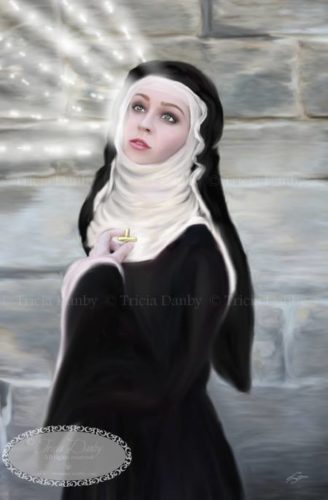
“Hildegard of Bingenc” by Tricia Danby
She had visions throughout her life, starting at age 3 when she says that she first saw “the Shade of the Living Light.” She hesitated to tell others about her visions, sharing them only with her teacher Jutta.
When she was 42, Hildegard had a vision in which God instructed her to record her spiritual experiences. Still hesitant, she became physically ill before she was persuaded to begin her first visionary work, the Scivias (Know the Ways of God).
Hildegard’s native tongue was an old dialect of German. She also wrote in Latin and an “unknown language” (lingua ignota) that she apparently invented and used for mystical purposes. It may be the oldest known constructed language in history.
Richardis fueled Hildegard’s creativity
Hildegard was nursed in her illness and encouraged in her writing by Richardis von Stade, a younger woman who was her personal assistant, soul mate and special favorite. Whether or not they were physically intimate, Hildegard’s actions suggest that she was a lesbian in the sense that her primary love interest was in women.
In 1151, Hildegard completed the Scivias and trouble arose between her and her beloved Richardis. An archbishop, the brother of Richardis, arranged for his sister to become abbess of a distant convent. Hildegard urged Richardis to stay, and even asked the Pope to stop the move. But Richardis left anyway, over Hildegard’s objections.
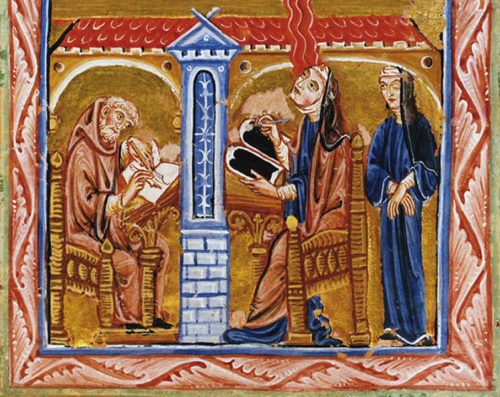
The holy fire of inspiration falls on Hildegard while Richardis stands behind her in a 13th-century manuscript illumination at the Biblioteca Statale in Lucca, Italy. (WikiArt)
Hildegard wrote intense letters begging Richardis to return: “I loved the nobility of your conduct, your wisdom and your chastity, your soul and the whole of your life, so much that many said: What are you doing?”
Richardis died suddenly in October 1151, when she was only about 28 years old. On her deathbed, she tearfully expressed her longing for Hildegard and her intention to return.
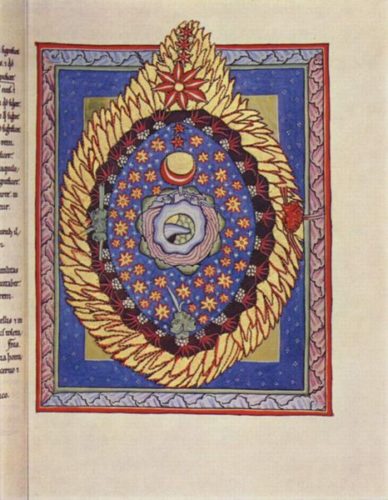
“The Universe” by Hildegard of Bingen (Wikimedia Commons)
Hildegard’s grief apparently fueled further artistic creation. Many believe that Richardis was the inspiration for Ordo Virtutum (“Play of Virtues”), a musical morality play about a soul who is tempted away by the devil and then repents. According to Wikipedia, “It is the earliest morality play by more than a century, and the only Medieval musical drama to survive with an attribution for both the text and the music.”
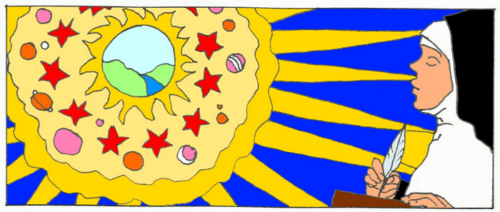
Hildegard appears with an abstract image of her own design in art from “Heavenly Homos, Etc.: Queer Icons from LGBTQ Life, Religion, and History” by Jan Haen. He tells the life stories of about 30 inspirational LGBTQ figures, including Hildegard.
In an era when few women wrote, Hildegard went on to create two more major visionary works, a collection of songs, and several scientific treatises. She was especially interested in women’s health. Her medical writings even include what may be the first description of a female orgasm.
Her efforts to get her work published were supported by Bernard of Clairvaux, another medieval saint with a same-sex soulmate and homoerotic visions of the divine.
Her value as an LGBTQ role model is tarnished by some of her writings. As a church leader, Hildegard had to support its policy against homosexual activity. For example, she wrote harrowingly harsh condemnations of homosexual behavior in Vision 78 of her “Scivias.”
But she often wrote about the divine feminine and the dignity of women, presenting sexuality in a somewhat positive way. She wrote, “Creation looks on its Creator like the beloved looks on the lover.” Many readers today delight in her erotic descriptions of marriage as a metaphor for the union of a soul with God. Hildegard writes:
The soul is kissed by God in its innermost regions.
With interior yearning, grace and blessing are bestowed.
It is a yearning to take on God’s gentle yoke,
It is a yearning to give one’s self to God’s Way.
 In the Symphonia, a collection of liturgical songs to Mary, Hildegard writes with ecstatic passion of her love and devotion to the Virgin Mary. She extols Mary as “greenest twig” (viridissima) and sings the praises of her womb, which “illuminated all creatures.”
In the Symphonia, a collection of liturgical songs to Mary, Hildegard writes with ecstatic passion of her love and devotion to the Virgin Mary. She extols Mary as “greenest twig” (viridissima) and sings the praises of her womb, which “illuminated all creatures.”

Hildegard painted Mary as the powerful queen of heaven in a detail from the Scivias
Hildegard painted a vision of Mary as the powerful queen of heaven in the Scivias. She shows Mary wearing a crown while reigning on a throne above a choir of angels. Below them are the apostles, patriarchs and prophets, virgins, confessors and martyrs. Mary does not hold the baby Jesus. Instead she boldly brandishes scepter and a globe. The fleur-de-lis on the end of the scepter represents purity and chastity, while the globe embodies the earth and/or the fruit that Mary brings as the New Eve.
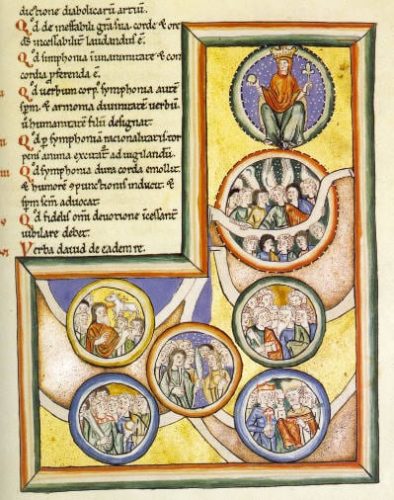
Hildegard’s full-page Scivias illustration shows Mary reigning above the angels and other heroes of faith.
Her songs to Mary are available for listening in the following video and on the Sequentia recording, “Hildegard von Bingen: Canticles of Ecstasy.” Her music is still just as beautiful today.
In the last year of her life, Hildegard got in a major conflict with church authorities after she took in a young man who had been abused by the church and excommunicated. He died in her care and was buried in the cemetery adjoining her convent. Church authorities wanted him exhumed from this holy ground, but she refused, insisting that he was reconciled to the church on his death bed. She even had the nuns remove the markers from every grave so his could not be identified. Enraged, the local bishop placed her convent under interdict, forbidding them from services, sacraments and singing. Hildegard fought back and the interdict was lifted shortly before her death.
Hildegard died on Sept. 17, 1179 at age 81. The sisters at her convent said they saw two streams of colorful lights cross in the sky above her room. She became a saint by popular acclamation.
Hildegard of Bingen honored the green web of life
One of the core concepts in Hildegard’s work is “viriditas,” the divine greening force of nature expressed in a combination of Latin words for “green” and “truth.” She led her monastery’s herbal garden and infirmary, recording her research and experiences in books about the medicinal properties of various plants, animals and precious stones. Her holistic approach emphasized the connection between individual human health and the health of the whole earth. She connected women and nature by celebrating Mother Mary and Mother Earth. All this makes her a forerunner of contemporary movements for ecology, environmentalism, reversing global warming and reducing climate change. In her Ave Generosa Hymn to the Virgin, she wrote
Your flesh rejoiced
just as a blade of grass on which the dew has fall’n,
viridity within it to infuse—just so it happened unto you,
O mother of all joy!
Hildegard was the subject of a major sermon by Episcopal Presiding Bishop Katharine Jefferts Schori when the House of Bishops met in Taiwan on Sept. 17, 2014. “Hildegard speaks scientifically and theologically of divine creativity as viriditas, reflecting both greenness and truth… Hildegard’s vision motivates all healers of creation who understand the green web of connection that ties creation together in Wisdom’s body,” she said.
Art and icons depict Hildegard of Bingen
Hildegard appears as a young woman in new portraits by Tricia Danby, a spiritual artist based in Germany and a cleric in the Old Catholic Apostolic Church. Her images reveal a sensuous side to Hildegard’s rapturous connection with God.
Stained-glass artist Plamen Petrov of Chicago is known for his window showing the male paired saints Sergius and Bacchus at St. Martha Church in Morton Grove, Illinois. His Hildegard window shows her illuminated with beautiful aquamarine colors.
Hildegard was sketched in blue with intense blue eyes by Tobias Haller, an iconographer, author, composer, and retired vicar of Saint James Episcopal Church in the Bronx, still assisting at a parish in Baltimore, Maryland. He is the author of “Reasonable and Holy: Engaging Same-Sexuality.” Haller enjoys expanding the diversity of icons available by creating icons of LGBTQ people and other progressive holy figures as well as traditional saints. He and his spouse were united in a church wedding more than 30 years ago and a civil ceremony after same-sex marriage became legal in New York.

“Saint Hildegard of Bingen” by Robert Lentz. Prints available at Amazon and Trinity Stores.
Robert Lentz, a Franciscan friar known for his innovative and LGBT-positive icons, portrays Hildegard with a wild rose. She used to dip a rose in the Rhine River and use it to sprinkle water on people as a blessing when she traveled between monasteries. Lentz is stationed at Holy Name College in Silver Spring, Maryland.
“Hildegarde of Bingen” is one of 39 historical and mythological women featured in “The Dinner Party,” an installation artwork by feminist artist Judy Chicago. Considered a milestone in 20th-century art, it consists of a triangular table with elaborate place settings for each woman. The place settings include embroidered runners, gold chalices and utensils, and hand-painted china plates with a raised vulva or butterfly form. Every item is crafted in a unique style that reflects the woman being honored. The place setting for “Hildegarde of Bingen” at “The Dinner Party” is based on the structure of a Gothic cathedral, including a stained-glass window effect.
LGBTQ-affirming creation theologian Matthew Fox has written two books on the life and work of Hildegard. The newest is Hildegard of Bingen: A Saint for Our Times: Unleashing Her Power in the 21st Century, which presents her as an “eco-warrior” who meets such luminaries as Albert Einstein, Howard Thurman, Dorothee Soelle and Clarissa Pinkola Estes. Fox also wrote Illuminations of Hildegard of Bingen.
Links related to Hildegard of Bingen
Pope sets date to declare two new church doctors (Catholic News Agency)
Ritual to Honor Hildegard of Bingen by Diann L. Neu (WATER)
Gebet zum Christus des Regenbogens (Rainbow Christ Prayer in German)
Oratio ad Christum Iris Arcus (Rainbow Christ Prayer in Latin)
To read this post in Spanish / en español, go to:
Hildegarda de Bingen y Richardis: la mística medieval y la mujer que amaba (canariasgayleslgtb blog)
Hildegarda de Bingen y Richardis: Una mística que amaba a otra mujer (Santos Queer)
To read this post in Italian / in Italiano, go to gionata.org:
La forza della visione. La vita della mistica Ildegarda di Bingen
Books about lesbian nuns
“Immodest Acts: The Life of a Lesbian Nun in Renaissance Italy” by Judith C. Brown
“Lieutenant Nun: Memoir of a Basque Transvestite in the New World” by Catalina De Erauso
“Lesbian Nuns: Breaking Silence” by Nancy Manahan and Rosemary Keefer Curb (editors)
Lesbian nuns from history
Q Spirit’s LGBTQ Saints series includes the following lesbian nuns:
Brigid and Darlughdach: Celtic saint loved her female soulmate
Jeanne Cordova: Lesbian nun who “kicked the habit” to be an activist
Hildegard of Bingen and Richardis: Medieval mystic and the woman she loved
Sor Juana Inés de la Cruz: Nun who loved a countess in 17th-century Mexico City
Walatta Petros: African nun shared a lifetime bond with a female partner in 17th-century
Coming to Q Spirit in the future:
Remembering Jeanne Deckers, Lesbian Catholic Who Won Fame as “The Singing Nun” (New Ways Ministry)
___
Top image credit: “St. Hildegard of Bingen and Her Assistant Richardis” by Lewis Williams. Prints of “Hildegard and Richardis” are available through Amazon and TrinityStores.com.
___
This post is part of the LGBTQ Saints series by Kittredge Cherry. Traditional and alternative saints, people in the Bible, LGBTQ martyrs, authors, theologians, religious leaders, artists, deities and other figures of special interest to lesbian, gay, bisexual and transgender and queer (LGBTQ) people and our allies are covered.
This article has evolved and expanded greatly since the first version was posted in September 2010. It was published on Q Spirit in September 2017, was enhanced with new material over time, and was most recently updated on Feb. 23, 2025.
Copyright © Kittredge Cherry. All rights reserved.
Qspirit.net presents the Jesus in Love Blog on LGBTQ spirituality.


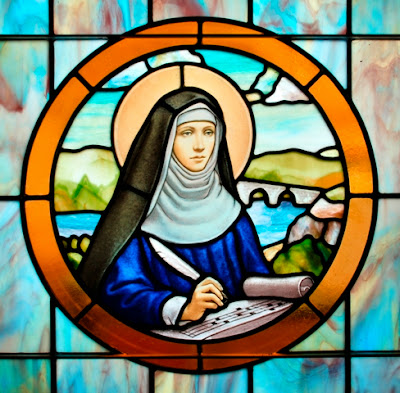



















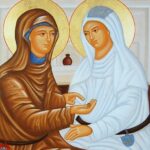
I have always admired Hildegard von Bingen, not only for her artistic and musical creativity, but also for her courage and the actions she took when, because she was a woman, her contributions were often not taken seriously by the men whom the Church placed in dominion over her.
Thank you for writing this article. I am pleased to see someone telling the truth about my beloved St. Hildegard, when many trad catholics wish to erase this part of her history. Ave Hildegardis!
This article says: “Whether or not they were physically intimate, Hildegard’s actions suggest that she was a lesbian in the sense that her primary love interest was in women” – without presenting any evidence that Richardis was anything more than a friend, and while admitting that Hildegard harshly condemned lesbianism in “Scivias”. If you want to retain any credibility, you’re going to need to stop misrepresenting things like this. At no point did Hildegard describe any romantic feelings or sexual encounters with Richardis (in fact she praises Richardis’ chastity, as you admit), and her lack of any male love interest was simply due to the fact that she had taken a vow of lifelong celibacy while joining a convent in which she was virtually cut off from men. Her writings in “Scivias”, which you yourself allude to, should certainly contradict any idea that she herself was a lesbian.
Hildegard and Richardis experienced a phenomenon called “spiritual friendship.” Aelred of Rievaulx wrote a treatise on it. It was essentially a celibate version of what we would call romantic love today. It was particularly popular in homosocial communities such as monasteries. You’ll notice that Kittredge said that Hildegard was a lesbian in that her primary love interest was a woman, which does not imply that she had sexual relations with Richardis. The other half of sexuality that people often forget is who people fall in love with. Hildegard and Richardis were undoubtedly in love with one another, and they did not have to have sex to show that. If you have read Hildegard’s works, you will notice that she condemns same-sex sexual acts, not same-sex love. As far as romantic feelings go, you can see similar writing styles throughout the Middle Ages that indicate deep and intimate feelings of affection, from Augustine to Anselm to Aelred to Hildegard. While it is anachronistic to call Hildegard a lesbian, she certainly had intimate feelings for at least one woman. As far as I am concerned, Kittredge did not misrepresent anything.
Citations: my Master’s degree in medieval European history with a focus on sexuality
I’m honored to get affirmation from an expert with a master’s degree in medieval European history!
McKenzie, I encourage you to comment on some of my other profiles of medieval saints, because you were responding to a critic (CGesange) who left similar comments finding fault with ALL my articles about historical saints.
This is a reply to McKenzie since the system doesn’t allow me to reply directly. The word Hildegard uses for “love” is just the same term that the people of the era routinely used constantly, even in form letters issued by governments. It does not prove that she felt romantic love for Richardis because she never describes any romantic feelings, she merely uses a very common term for literally any form of affection.